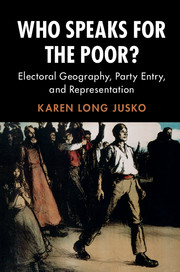Book contents
- Frontmatter
- Dedication
- Epigraph
- Contents
- List of Figures
- List of Tables
- Preface and Acknowledgments
- 1 Who Speaks for the Poor?
- 2 How Electoral Geography Matters
- 3 New Parties and the Changing Electoral Geography of Contemporary Democracies, 1880–2000
- 4 The Populists and “Third-Party Men” in America
- 5 Strategic Entry of the CCF and Social Credit in Canada
- 6 The Implications of Electoral Geography for British Labour
- 7 The Swedish Social Democratic Party, and the Long-Term Implications of Electoral Reform
- 8 “It Didn't Happen Here”: The General Implications of Electoral Geography for the Political Representation of the Poor
- References
- Index
- Miscellaneous Endmatter
3 - New Parties and the Changing Electoral Geography of Contemporary Democracies, 1880–2000
Published online by Cambridge University Press: 05 September 2017
- Frontmatter
- Dedication
- Epigraph
- Contents
- List of Figures
- List of Tables
- Preface and Acknowledgments
- 1 Who Speaks for the Poor?
- 2 How Electoral Geography Matters
- 3 New Parties and the Changing Electoral Geography of Contemporary Democracies, 1880–2000
- 4 The Populists and “Third-Party Men” in America
- 5 Strategic Entry of the CCF and Social Credit in Canada
- 6 The Implications of Electoral Geography for British Labour
- 7 The Swedish Social Democratic Party, and the Long-Term Implications of Electoral Reform
- 8 “It Didn't Happen Here”: The General Implications of Electoral Geography for the Political Representation of the Poor
- References
- Index
- Miscellaneous Endmatter
Summary
This book presents a general theory of party formation and entry in which demographic changes present political entrepreneurs with important opportunities. When a particular group becomes pivotal in legislative elections across some number of districts, and especially when this group is excluded from local partisan networks because of its recent arrival or because of suffrage restrictions, political entrepreneurs can pursue their office-seeking goals by mobilizing this group as a core constituency. While most of this book will test this claim by examining the conditions under which political entrepreneurs will mobilize a low-income constituency, this chapter will present a broadly comparative analysis that will show that new parties generally enter electoral competition following major changes in electoral geography. Specifically, for a large number of developed democracies, the analysis presented here will track local population changes from around 1880 through 2000, and show that all new parties are more likely to enter electoral competition during those periods in which we observe the largest changes in district electorates. By estimating the magnitude of local population change – evidence of internal migration or immigration – this analysis will focus attention on key periods in which new electoral opportunities likely presented themselves to political entrepreneurs.
The following section summarizes the earlier argument about why concentrated demographic changes represent electoral opportunities for new parties. Then, drawing on data for a large number of countries, and an extended period of time, this chapter develops a measure of local population change. Finally, this chapter uses data on the total number of new parties entering electoral competition in a particular decade as the dependent variable in an analysis that links local population change to electoral opportunity and new party formation.
LOCAL POPULATION CHANGE AND OPPORTUNITIES FOR PARTY ENTRY
Chapter 2 developed an account of party formation in which political entrepreneurs are faced with two decisions: (1) whether or not to form a new party (i.e., announce a policy platform), and (2) where to recruit candidates (i.e., enter electoral competition). When the political entrepreneurs face an established party system and a stable distribution of voters, the barriers to entry are high. The established parties have adopted platforms that maximize their share of seats in the legislature, and cultivated local partisan networks that sustain their electoral success.
- Type
- Chapter
- Information
- Who Speaks for the Poor?Electoral Geography, Party Entry, and Representation, pp. 30 - 49Publisher: Cambridge University PressPrint publication year: 2017



